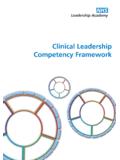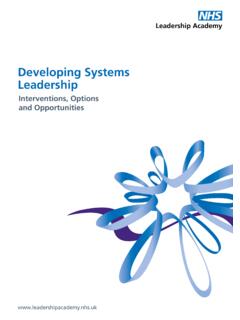Transcription of Talent Management Conversation Tool - Leadership Academy
1 Talent Management Conversation Tool A guide for managers and employees Version 1: July 2014. Contents Introduction 3 Holding the Talent Conversation 14. Use of the Talent Management Conversation Tool 3 Adopting a coaching style in the Talent Management Conversation 15. What is Talent Management ? 4 After the Talent Conversation 16. Who is Talent Management for? 5 Rating behaviours and performance 18. Overview and use of the Talent Management Conversation Tool 6. Talent Grid Conversation Tool 9 Support The Talent Conversation 10 Appendix 1: Navigating the Talent Management Conversation Tool 22. Flow chart for the Talent Conversation process 11 Appendix 2: Blank template Talent Management Conversation Tool 41.
2 Preparing for a Talent Conversation 12 Appendix 3: Dos and don'ts 44. Special arrangements and considerations for the Conversation 13 Appendix 4: High contrast Talent Management Conversation Tool (easy read) 47. Talent Management Conversation Tool Introduction This tool has been designed by the NHS Leadership Academy in collaboration with our local delivery partners (LDPs) to bring together good practice around NHS Talent Management (TM). The tool can be used to compliment wider TM tools available to your organisation. This tool is one of a suite of tools and forms part of an inclusive national approach Use of the Talent Management to TM for all NHS staff, considering the potential and value they bring to their current roles as well as reaching and maximising their future potential in the NHS.
3 Conversation Tool Having skilled, motivated well supported and developed staff is our greatest assurance that we can provide the necessary care to our patients and communities. This tool should be used when identifying individuals who will be nominated to the Evidence shows that if we foster a culture where we engage and care for our staff NHS Leadership Academy Professional Leadership Programmes. they will value and care for our patients. Only those who fall into the Green category of the Talent Grid should ideally be considered for progressive Leadership development and access to local, regional or national programmes. The main part of the tool is the open, honest and constructive Conversation between the manager and member of staff to explore where they are now, An inclusive national where they want to be, and how to get there or to simply identify and maximise how they are currently performing.
4 Approach to Talent To see an effective Talent Conversation in practice go to Management . The tool may be used to enhance the appraisal process, but equally can be undertaken as a standalone process. Talent Management Conversation Tool 3. What is Talent Management ? Talent Management (TM) represents organisations' efforts to attract, develop and TM allows an organisation to have a rounded picture of the individuals it employs, retain skilled and valuable employees. Its goal is to have people with the capabilities, future skills and the styles and behaviours needed to take the organisation forward commitment and behaviours needed for current and future organisational success. to effectively deliver against its priorities.
5 Ultimately, aligning the right people to the This means making sure we have: right roles with the right values will lead to improved quality of healthcare services and outcomes for our patients will continue to improve. As part of the TM and maximising potential process, we look at reviewing The right people, in the right roles, employees against performance, behaviour, ambition and raw potential to move 1 with the right values onwards and upwards. By looking at where employees sit on these scales it helps us to understand how best to support them in their development to reach their full potential in the wider NHS. With access to the right opportunities, In common with the most national and international organisations, we look to 2 exposure, stretch and development to provide a Talent Management and maximising potential process that works for all of our staff.
6 Reach their potential The key element to any successful TM approach in maximising an individual's potential is when managers and staff are able to have open and constructive conversations around their potential; where they are Whether this be in their current role, 3 or for a future role now, where they want to be, and how to be supported to get there. the right people the right roles . Talent Management Conversation Tool 4. Who is Talent Management for? Talent Management should consider all individuals in an organisation. It should cover the development they require, the value they bring, and the position(s) that best suit their skills currently and into the future within an organisation and/or elsewhere in their career journey.
7 Talent and career development and maximising their potential is necessary for the retention of employees no matter what their seniority and position We all need to feel that we are listened to, understood and valued in our within the organisation; whether that is for example; roles to achieve our maximum potential. Whether you are someone who is a reliable key contributor, someone who needs support to be able to reach your potential or someone exceeding expectations who is ready for a step l A professional in their field who wants to maintain their CPD to change. Talent Management is about considering everyone as an individual maximise their potential in their current role and use their expertise and the development that is right for them and making them feel rewarded to develop others around them and able to do a good job within our NHS.
8 L A developing professional' who needs targeted support to reach their potential in their current role l A transition employee' who has just started in a role and needs targeted support to reach their potential in their new role, or l A role model' employee who has mastered their current role and shows high potential to make a step change to the next path in their career in the NHS. Talent Management Conversation Tool 5. Overview and use of the Talent Management Conversation Tool This tool helps staff and managers to measure performance' (what you achieve) and behaviours' (how you achieve it) of individuals against their demonstrated potential'. (capacity, ambition, motivation, readiness) to move on in their career path in the immediate, short or longer term on their journey to reach their full potential.
9 When having Talent discussions, both the manager and individual should refer to the Healthcare Leadership Model and supporting Guidelines for using the Healthcare Leadership Model within Talent conversations'. You should consider evidence such as: l Performance appraisal and behavioural feedback tools such as 360 degree tool to help align their level of performance; partially meeting, meeting or exceeding expectations. l Managers should then, through coaching , work through the individual's ambition and potential to move on in order to get a sense of; ready now, ready soon or content to stay within their current professional role. All of this allows you to identify where an individual sits on the Talent grid.
10 (See Page 9). l You can then consider the most appropriate development opportunities, such as maintaining CPD and stretching out of their role or development to help them reach the next step on their journey to reach their full potential. Talent Management Conversation Tool 6. Considerations for people in the following coloured areas of the 9 Box Grid Green For those in the Ready Now' category who need support to reach their full potential, these individuals should be put forward to Leadership programmes. Those who are Key Generalists' and Future Emergent Potential' may also be given similar opportunities, however more targeted discussions should be had to explore if any chosen programme is right for their development needs.















